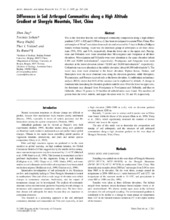| dc.description.abstract | This is the first time that the soil arthropod communitycomposition along a high-altitude gradient (3,837, 4,105, and5,050 m a.s.l.) has been investigated in eastern Tibet, China.Five soil samples of 50 cm super(2) were taken from each site andextracted for 7 days in Berlese/Tullgren funnels without heating.Acari was the dominant group of arthropods at all three elevations(79%, 53%, and 54%, respectively, from the lower site to the uppersite). Prostigmata and Oribatida were more abundant thanMesostigmata and Astigmata at all three elevations. Mesostigmataand Oribatida were most abundant at the upper elevation (about8,300 and 29,000 individuals/m super(2), respectively).Prostigmata and Astigmata were most abundant at the lowerelevation (about 170,000 and 20,000 individuals/m super(2),respectively). Collembola was most abundant at the middleelevation (about 68,000 individuals/m super(2)). The insect taxawere most abundant at the lower elevation. Diptera larvae,Protura, and Homoptera were the most abundant taxa along theelevation gradient, while Hemiptera, Thysanoptera, and Proturaoccurred only at the lower elevation. A multivariate redundancyanalysis (RDA) shows that 64% of the variance can be explained byaltitude. A change in dominant mite taxa along the elevationgradient could be seen. From the lower to upper sites, thedominant taxa changed from Prostigmata to Prostigmata andOribatida, and then to Oribatida. About 33 genera in 24 familiesof oribatid mites were found. The numbers of genera from thelower, middle, and upper elevation were 14, 20, and 19,respectively. | en_US |
